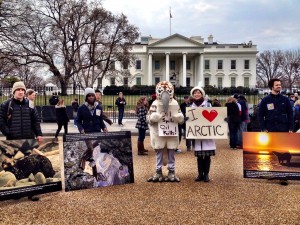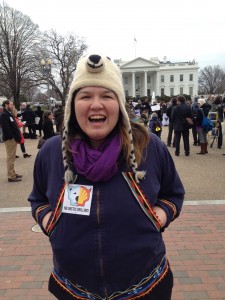
It’s the 26th anniversary of America’s second largest oil spill, when an Exxon tanker leaving Valdez Arm ran aground, leaking 11 million gallons of North Slope Crude into Prince William Sound. In Washington D.C., environmental activists marked the occasion with a demonstration in front of the White House. Their message was less about Exxon and tanker safety than it was about Shell
and its plans to drill in the Chukchi Sea.
“Hey, Obama: Yes you can! Stop Shell Oil’s dirty plan,” the crowd chanted.
Dozens of people gathered at lunchtime outside the White House fence. They carried big photos of oiled animals and signs that say “oil kills” and “I heart Arctic.” No one wore a polar bear suit, but there was a girl cocooned in a giant sandpiper costume. She says she’s Liszka Bessenyey, of Anchorage.
“I’m 15-years-old,” Bessenyey said, from inside the bird suit. “I’m a freshman at Service High School.”
Many of the demonstrators work at Washington-based environmental groups. Others, like the sandpiper, were in the capital for “wilderness week” an annual campaign on Capitol Hill to advance environmental priorities. One speaker at the megaphone was Allison Warden, an Inupiaq performance artist with roots in Kaktovik.
“My people will no longer be Inupiaq because we won’t be able to live off the land and off the water in the way that we’ve been,” Warden said. “So, every single one of you listening here, it’s important for you to stand up.”

Inupiaq leaders, including North Slope Borough Mayor Charlotte Brower, were just in Washington, arguing in favor of Arctic development, including oil drilling in the Arctic Refuge. ButWarden says the people she talks to are worried that drilling offshore will disrupt the whale migration, particularly if there’s a spill.
“It would permanently change our relationship to the ocean and to the animals,” Warden said. “They would be in a different state. And our culture that revolves around the whale would no longer be the same.”
Shell has said it wants to return to drill in the Chukchi Sea this summer but it has several legal and logistical hurdles to clear. The Bureau of Ocean Energy Management is expected to announce within the week its record of decision on Lease Sale 193, which includes Shell’s leases in the Chukchi, following a lawsuit. Assuming the leases are reaffirmed, it’s not the final green light.
“Shell still needs to get an exploration plan approval and the permits that are associated with that,” says Peter Van Tuyn, an Anchorage environmental lawyer — and the father of the giant sandpiper girl. He’s closely following Shell’s permitting process, on alert for flaws.
“The exploration plan should be a major hurdle, absolutely, because there are such fundamental challenges to drilling in the Arctic and that’s the place where those specific challenges need to be addressed in the permitting scheme,” he said.
Shell has repeatedly said it won’t resume its Arctic drilling program unless it’s sure it can do so safely and responsibly.
Liz Ruskin is the Washington, D.C., correspondent at Alaska Public Media. Reach her at lruskin@alaskapublic.org. Read more about Liz here.





